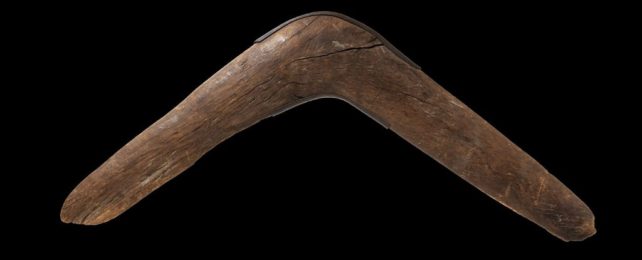A wooden boomerang might not possess the many arms of a Swiss army knife, but the uses of this ingenious tool by Australia's First Nations peoples are manifold.
The wooden, elbow-shaped instrument is popularly known around the world as an aerodynamic throwing stick. But depending on how the tool is made, it can also be used as a battle club, a digging stick, a hammer, a fire starter, a toy, a musical instrument – and even, it turns out, a sharpener of bone and stone tools.
In a new study, researchers in Australia have shown that hardwood boomerangs are tough enough to be used even for flint-, bone- and stone-knapping.
One of the authors is a Birrunburra / Bundjalung / Yugambeh / Yuggera / Turrbal man, and he contributed two of the four hardwood boomerangs used in the experiments.
Members of the Milan Dhiiyaan mob also shared their Traditional knowledge and some bubarra / garrbaa / biyarr (boomerangs) with the authors.
When expert knappers were given these hardwood boomerangs to use, they were able to flake away the edges of bone instruments. This left scratches on the wooden tool that closely match those seen on older boomerang artifacts held in museums.
Researchers previously suspected these markings were the product of wood tapping against stone or bone, and the new experiments show that is very much a possibility.
"In our article, we put together traditional knowledge and experimental archaeology to investigate a forgotten use of boomerangs: modifying the edges of stone tools," says archaeologist Eva Francesca Martellotta from Griffith University in Australia.
"Traditionally handcrafted experimental replicas of boomerangs proved very functional to shape stone tools. Our results are the first scientific proof of the multipurpose nature of these iconic objects."
"While our results for the first time scientifically quantify the multipurpose nature of daily tools like boomerangs, this is something that Aboriginal people have known from a very long time," Martellotta adds.

The findings support the hypothesis that Australia's First Nations peoples regularly used hardwood boomerangs for retouching purposes.
Since the European invasion in the late 1700s, however, the multipurpose nature of the boomerang has received little attention from archaeologists or ethnographic researchers.
Earlier this year, some of the same researchers published a systematic review of the scientific literature on boomerangs. Their analysis revealed that most previous studies have focused only on the aerodynamic properties of returning boomerangs, and little else.
Few other functions of the boomerang have been considered, despite reports of many different uses. Returning boomerangs may have become the most famous of the lot, but not all boomerangs are designed to fly back. Some are designed to fly straight and true.
In the video below, a Marrawarra / Barkindji man by the name of Brendan Mitchell walks through the numerous ways that boomerangs are designed and used today. As he cheekily demonstrates, some make for great back scratchers.
While it might seem pointless to use wood against rock, this might have been humanity's first step in the history of flint- and stone-knapping.
The markings found on ancient boomerangs in Australia closely resemble bone retouchers from the early phase of the Stone Age in Europe. Neanderthals even used this technique as far back as 500,000 years ago.
Some of these Paleolithic bone retouchers have caught and held micro flakes of flint that still remain stuck in the fossilized wood to this day.
In the current study, some hardwood boomerangs showed the same tiny chips.
Across great distances and great lengths of time, humans have been using hard wooden objects to reshape their tools.
The Australian boomerang could very well belong in that arsenal.
The study was published in PLOS ONE.
